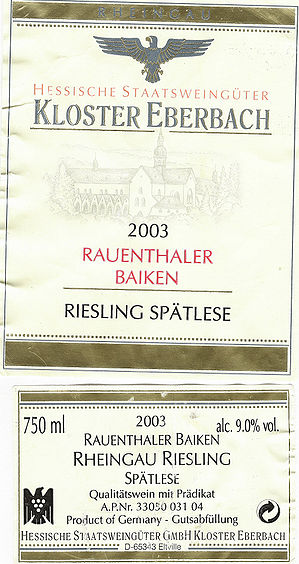
German Wine Label
Encyclopedia

MSNBC
MSNBC is a cable news channel based in the United States available in the US, Germany , South Africa, the Middle East and Canada...
Life Style editor describes German wine
Wine
Wine is an alcoholic beverage, made of fermented fruit juice, usually from grapes. The natural chemical balance of grapes lets them ferment without the addition of sugars, acids, enzymes, or other nutrients. Grape wine is produced by fermenting crushed grapes using various types of yeast. Yeast...
labels as a "thicket of exotic words and abbreviations" that require "the vinous equivalent of Cliff notes
CliffsNotes
CliffsNotes are a series of student study guides available primarily in the United States. The guides present and explain literary and other works in pamphlet form or online. Detractors of the study guides claim they let students bypass reading the assigned literature...
to parse."
Required Information
German wineGerman wine
German wine is primarily produced in the west of Germany, along the river Rhine and its tributaries, with the oldest plantations going back to the Roman era. Approximately 60 percent of the German wine production is situated in the federal state of Rhineland-Palatinate, where 6 of the 13 regions ...
law regulates that at least six items of information be present on the label.
- Name of the producer or bottler (e.g.: Staatsweingüter Kloster EberbachEberbach AbbeyEberbach Abbey is a former Cistercian monastery near Eltville am Rhein in the Rheingau, Germany. On account of its impressive Romanesque and early Gothic buildings it is considered one of the most significant architectural heritage sites in Hesse, Germany...
)
German wine domaines/"château
Château
A château is a manor house or residence of the lord of the manor or a country house of nobility or gentry, with or without fortifications, originally—and still most frequently—in French-speaking regions...
x" are often called "Kloster", "Schloss", "Burg", "Domaine" or "Weingut" followed by some other name.
- A.P.Nr Amtliche Prüfnummer Quality control number (e.g.: 33050 031 04)
The first number (1-9) relates to the German wine region where the wine was produced and tested (e.g. 3-Rheingau). The second 2 or 3 digit number indicates the village of the vineyard (e.g. 30-Rauenthal)). The next two digits represents the particular wine estate (e.g. 50-Kloster Eberbach). The following 2 to 3 digit number is the sequential order that the wine was submitted by that producer for testing (e.g. 031 - this was the 31st wine submitted by Kloster Eberbach for testing). The final two digits is the year of the testing, which is normally the year following the vintage
Vintage
Vintage, in wine-making, is the process of picking grapes and creating the finished product . A vintage wine is one made from grapes that were all, or primarily, grown and harvested in a single specified year. In certain wines, it can denote quality, as in Port wine, where Port houses make and...
(e.g. 04 - the wine was tested in 2004).
- Anbaugebiet, i.e. region of origin (e.g.: Rheingau)
- Volume of the wine (e.g.: 750ml)
- Location of the producer/bottler (e.g.: Eltville)
- AlcoholAlcoholIn chemistry, an alcohol is an organic compound in which the hydroxy functional group is bound to a carbon atom. In particular, this carbon center should be saturated, having single bonds to three other atoms....
level (e.g.: 9.0% vol)
Additional information
Though not required, German wine labels may also include- GrapeGrapeA grape is a non-climacteric fruit, specifically a berry, that grows on the perennial and deciduous woody vines of the genus Vitis. Grapes can be eaten raw or they can be used for making jam, juice, jelly, vinegar, wine, grape seed extracts, raisins, molasses and grape seed oil. Grapes are also...
variety (e.g., RieslingRieslingRiesling is a white grape variety which originated in the Rhine region of Germany. Riesling is an aromatic grape variety displaying flowery, almost perfumed, aromas as well as high acidity. It is used to make dry, semi-sweet, sweet and sparkling white wines. Riesling wines are usually varietally...
) - Prädikat level of ripeness (e.g., SpätleseSpätleseSpätlese is a German wine term for a wine from fully ripe grapes, the lightest of the late harvest wines. Spätlese is a riper category than Kabinett in the Prädikatswein category of the German wine classification and is the lowest level of Prädikatswein in Austria, where Kabinett is classified in...
) - Vintage year (e.g., 2003)
- Taste, such as dry (trocken) or off-dry (halbtrocken)
- Vineyard name (e.g.: Rauenthaler Baiken, a single vineyard). The village name (e.g.: Rauenthal") is normally identified by the possessive form "-er" suffix and is sometimes followed by the vineyard name ("Baiken").
- If the wine is estate-bottled (Erzeugerabfüllung or Gutsabfüllung), bottled by a co-op (Winzergenossenschaft), or by a third party bottler (Abfüller).
- Address of the winery
- The logo of the Association of German Prädikat Wine Estates (Verband Deutscher Prädikats- und QualitätsweingüterVerband Deutscher Prädikats- und QualitätsweingüterVerband Deutscher Prädikats- und Qualitätsweingüter e.V. or the Association of German Prädikat Wine Estates, is an organisation where most of Germany's top wine producers are members. It is commonly known under its acronym VDP...
, or more commonly VDP) which is awarded to the top 200 producers, as voted among themselves. The logo is a black eagle with a cluster of grapes in the center. The winery in the image example has the VDP logo. While not a guarantee, the presence of the VDP logo is a helpful insight into the quality of the wine.

